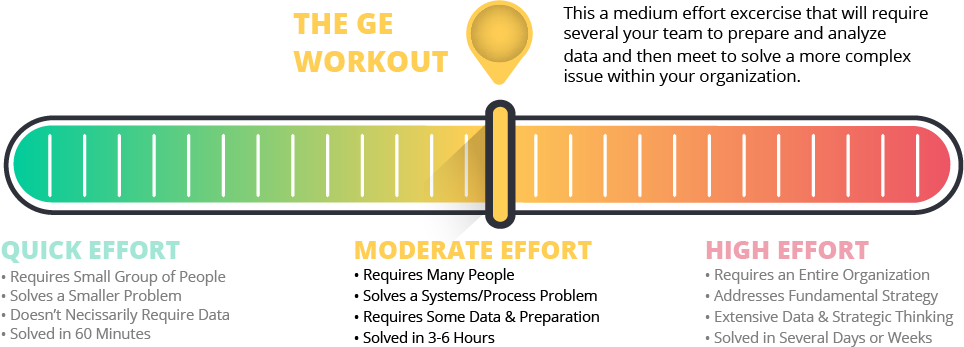With today’s ever-evolving world and the speed at which organization’s change, it’s more important than ever to create an environment and team with the agility to swiftly adapt to your changing environment. In the second post of our Strategic Decisions newsletter series, we’ll be covering an exercise we adapted from General Electric to work out medium difficulty organizational issues.
In our introductory post, we covered the common problems organizations face during decision making, outlined the ground rules for great decision making, learned about the sliding scale of effort for problem solving, and covered an exercise to solve simple strategic issues.
REFRESHER – Decision Making Ground Rules
When we work with clients, these are the ground rules we often provide to help set the expectation about what goes into solving a problem and what the expectations are from everyone involved in the process. These healthy ground rules help communicate both how you’ll interact and outlines what constitutes a good solution:
- Any decision involves some basic information, data gathering, and analysis. We never act on gut alone.
- Proposals to a problem must render a solution.
- Build in some “hang time” to weigh the options.
- Follow-through: communicate, implement, and validate if a solution is working. Adapt if necessary.
- Don’t move too quickly. All discussions must have dialogue (understanding) before discussion (decision). Otherwise, decisions don’t stay made.
REFRESHER – Identifying the Level of Effort Needed to Make a Decision
Before making any decision or deciding any approach, assess the level of effort it will take to address a problem or challenge. We’ve created a handy sliding scale outline of the key characteristics that influence how difficult a problem may be to solve and what will be required of your team to solve said problem.
GE WorkOut Worksheet
Now that we’ve covered the ground rules and gave a proper introduction for problem solving, we can cover this simple exercise to guide your organization to solve strategic issues.
OVERVIEW
- When to Use: To develop a new process, work-out issues in current process in order to overhaul and improve.
- Why: To empower those closest to the problem or issue with the ability to create the solutions to be more efficient and effective.
- Ideal Participants: 5-7 who are actively working in or impacted by the current process.
- Time Needed: 3-5 hours.

Pre-Session Activities
Identify the Problem Area
Before embarking upon this activity, it’s important to at minimum outline the problem area you’d like to address. Identifying a problem area gives your organization a set of guard rails to operate within. As a management team, identify a problem or strategic issue area before beginning this process. An example of this may be something like, “We have systems or process issue that impedes our shipping. How might we improve our poor shipping times?”
Identify Potential Participants
Ideally, this team will be comprised of 5-7 teammates who directly influence a problem or strategic issue you need solved. This can be comprised of a traditional team, or you can create one using cross-functional team members. Just ensure the WorkOut team has the knowledge and capability to address the general issue you’re seeking to solve.
Prepare Participants
It is crucial you make it clear the WorkOut is not just a gripe session or a wishing session. Creativity is encouraged, but challenge your participants to address your problem with the per view of their expertise.
For this level of problem solving, there will need to be some preparation and data analysis completed prior the session. Once you’ve selected your team, prepare your participants by informing them of the general issue at hand. Ask each to pull relevant information, data, and complete an analysis prior to the start of the session. Use your best judgement and consider the amount of time team members will need to prepare for this meeting. As a good rule of thumb, each team member should spend a few hours (1-2) preparing for this meeting.
HOW IT WORKS
Step One – Clearly Define & Agree on the Problem to Be Solved (1 Hour)
Discuss and agree on what your organization or team needs to fix, accomplish or avoid. Remember, this clearly defined problem must stay within the guard rails of what the executive team articulated.
It’s important to clearly state your problem and its impact. We recommend stating it in a single sentence and putting it up for everyone to see once it’s been decided.
Step Two – Brainstorm (1 Hour)
Using the grid provided below, brainstorm the possible areas that need to be eliminated (red sticky), modified (blue), created new (green) to solve your articulated problem. Use one idea per sticky, per box. Not all boxes need an idea.

Step Three – Decide (1 Hour)
After your brainstorm, discuss what’s on the board. Have a thoughtful conversation and start by eliminating the actions you know you don’t want to take. At the conclusion of the hour, agree on the what MUST BE DONE to solve your clearly articulated problem.
Step Four –Present (1-Hour Post Meeting)
Once you’ve decided on what your solution is, present your findings to the executive team. You can do this in a separate meeting or as a continuation from your working session. Choose whichever works best for your organization.
Step Five – Commit & Rollout (Ongoing)
Document the new process or solution. Take action on those areas that need work to fully implement. Roll it out to the team. This phase will vary in time based on your organization.
Wrapping Up
As we continue in this newsletter series, we will be covering a few other exercises for your team to leverage in the strategic decision-making process. We hope these exercises will be beneficial from a process perspective, but more importantly, we hope it helps empower your team to experience the agility and velocity of a high-functioning, well-oiled team!












